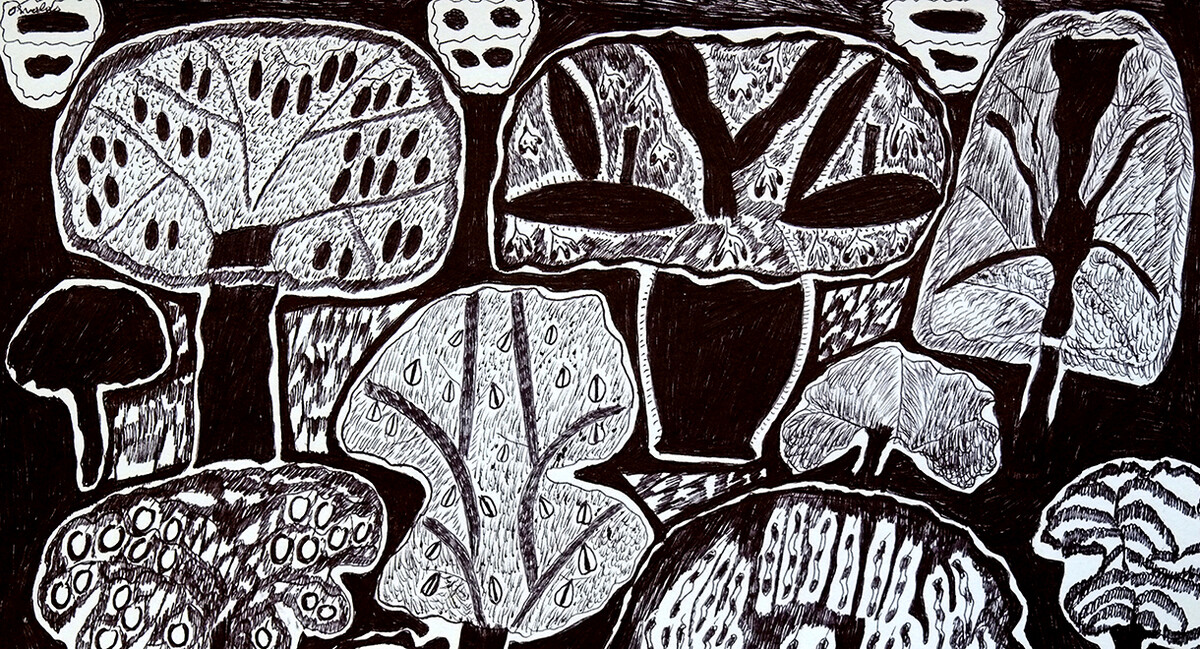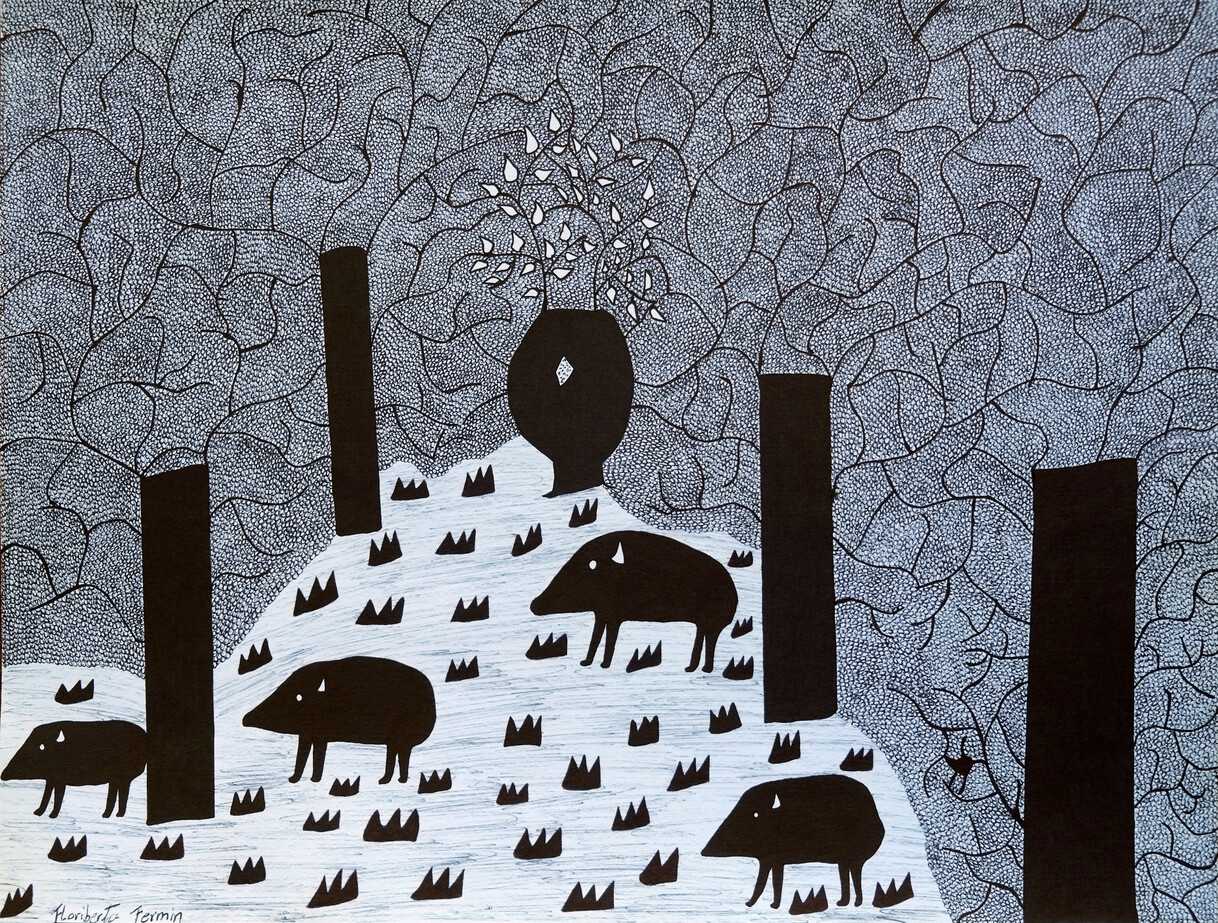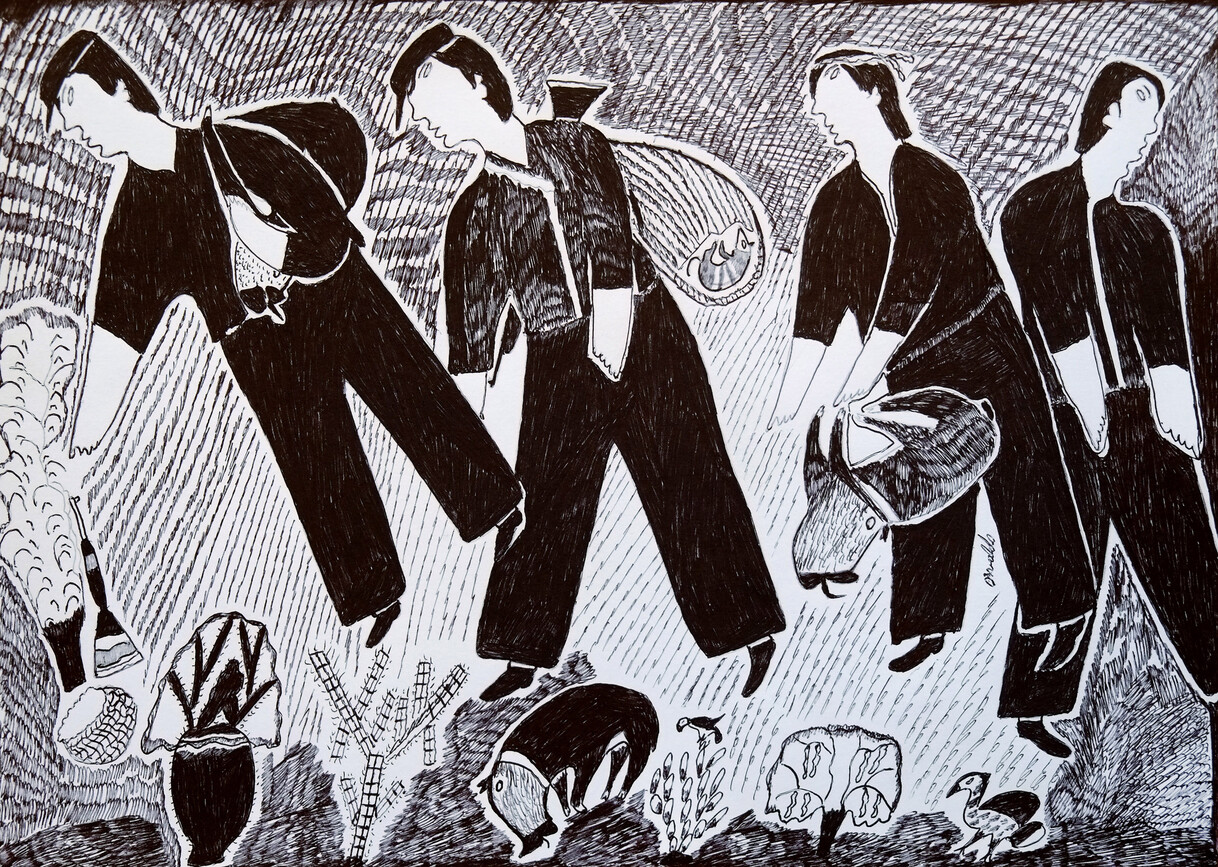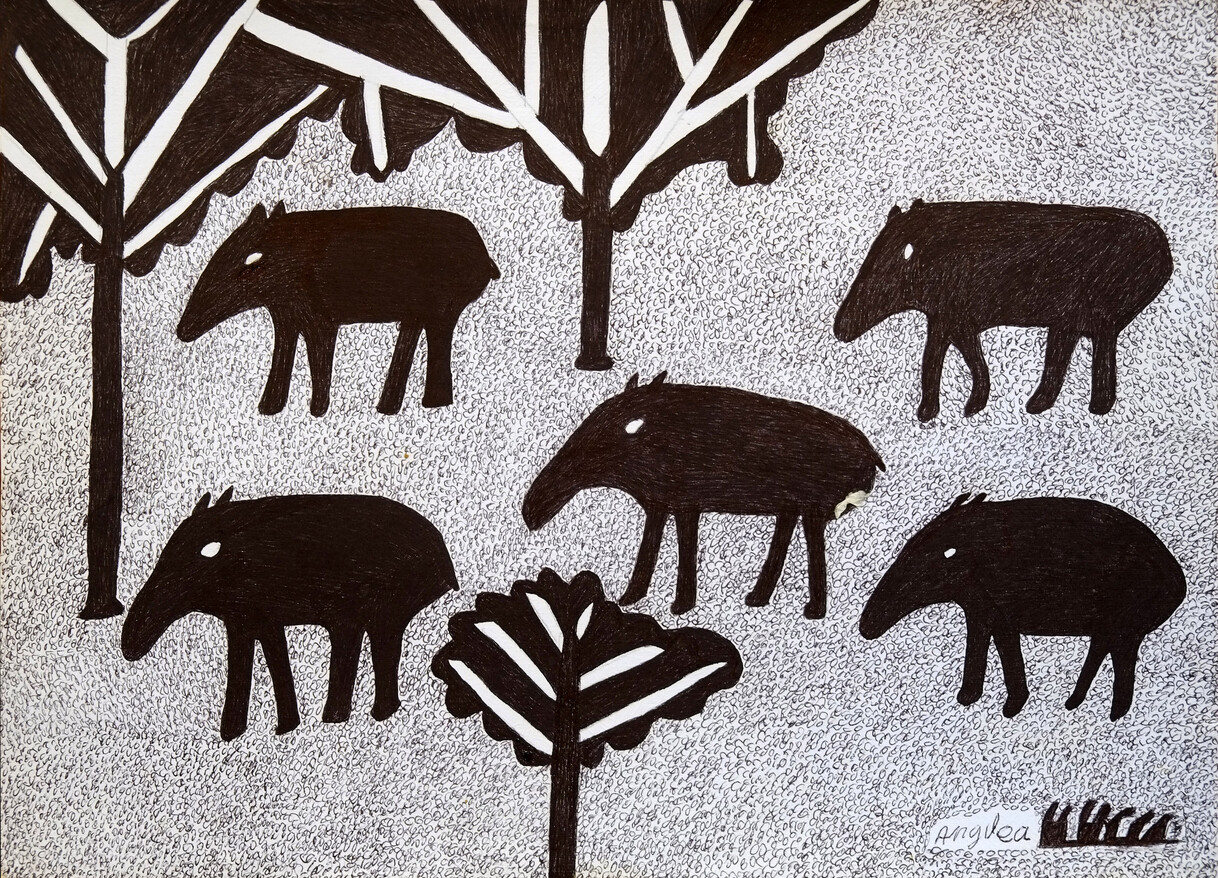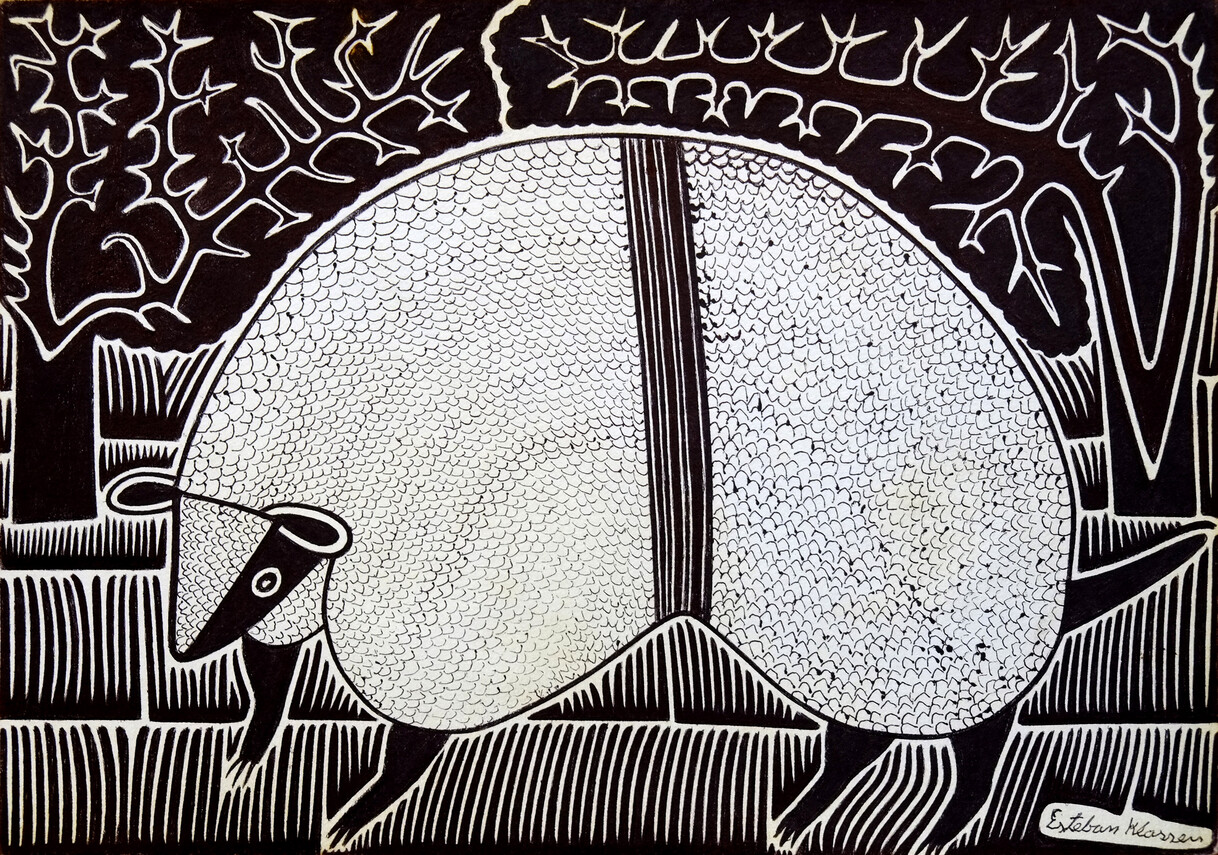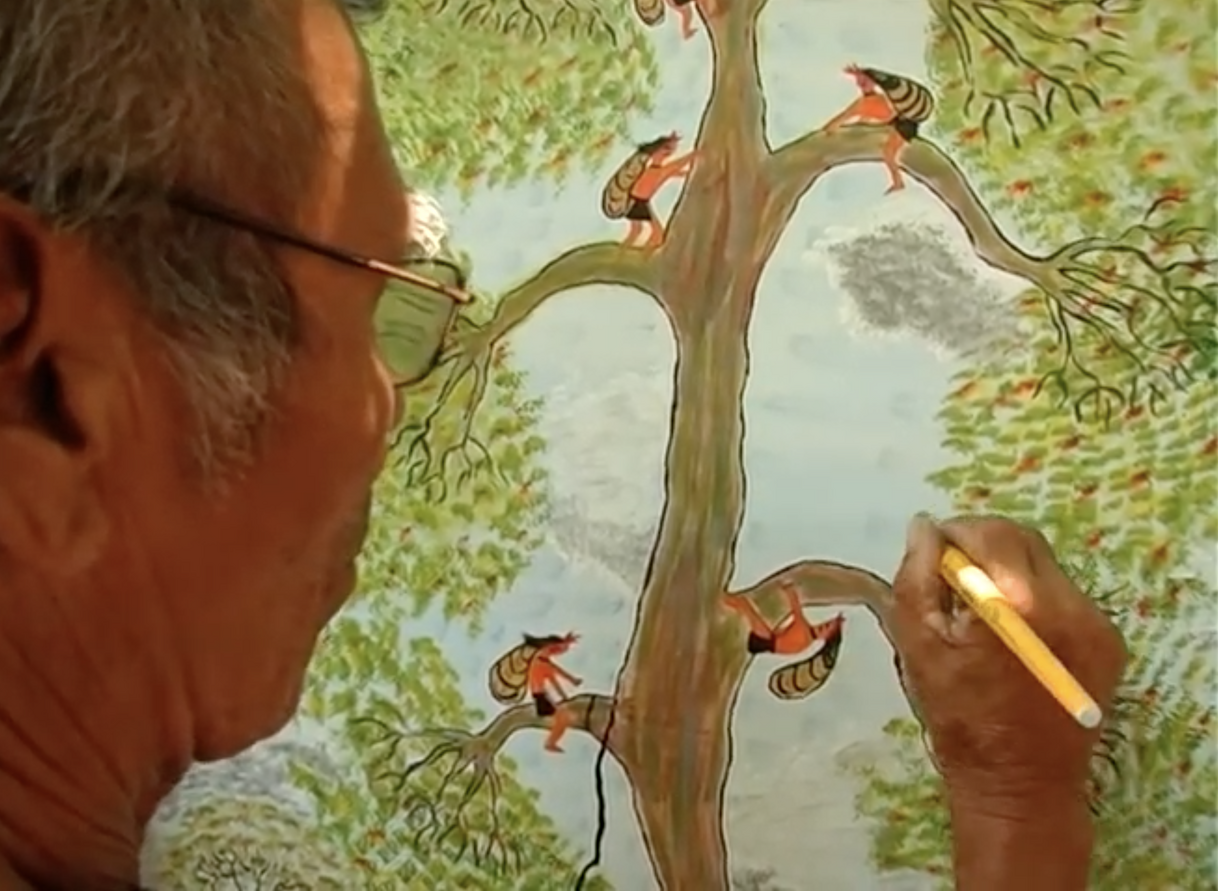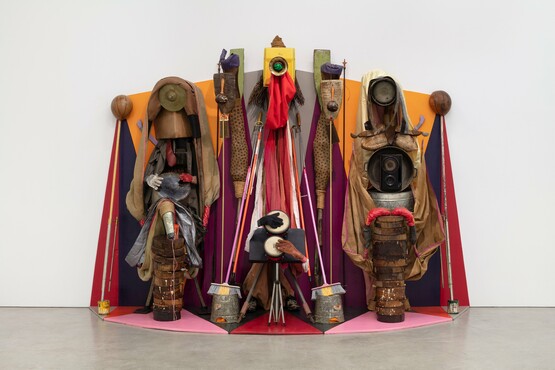Worldviews: indigenous artists, informants and the rhetoric of decolonisation in Paraguay
by Sofia Gotti • June 2021
Any study approaching the theme of indigenous art must reckon with the colonial history that has largely defined the interpretation of indigeneity from a hegemonic perspective. It must also interrogate the urgency felt in recent years to reassess indigenous culture, to incorporate it within global historiography and to feature it in public institutions, museums and universities invested in the project of decolonisation.1 The theorists Suely Rolnik and Felix Guattari provide a useful framework through which to understand the artistic production, or expression of singularity, of indigenous artists. Any emerging singularity brings about two kinds of micropolitical response: a normalising response or an attempt to use that singularity to initiate a process that may change the situation, and perhaps not just locally.2 Here, Rolnik and Guattari refer to emerging singularities as worldviews and ways of being that stray from hegemonic notions of normativity.3 For Rolnik and Guattari, the response to the emergence of such singularities will be micropolitical. What they call ‘active’ micropolitics are the actions of a processual subject, able to embody a process of resistance and reconfiguration of the colonial racialising capitalist regime – Rolnik’s definition. The question is, how can we avoid the risk of normalising what fits within a decolonial narrative, and instead consider the singularities of indigenous artists as catalysts of change ‘not just locally’?
This article examines the worldviews expressed by a small number of Guaraní, Ishír Chamacoco and Nivaclé artists working in the capital Asunción and the region of El Chaco, occidental Paraguay. Over the past decade in particular, these artists have begun portraying their cosmovision or worldview, which includes their surroundings, their myths and history. The medium frequently chosen by these artists is ballpoint pen on paper – using the same pens given to many indigenous peoples by anthropologists and missionaries eager to learn about indigenous culture. The themes that emerge from their work implicate issues around ecology, decolonisation and the processes by which indigenous contemporary art practices are being embedded within the discourse of art history. In addition to offering an introduction to the work of these artists, this article examines three ideas containing tensions and contradictions. Such contradictions aid our understanding of their practices as well as the cultural dynamics that led to the emergence of these artists on the local and international cultural scenes. First is the notion of mestizaje, a term for the mixing of European and indigenous populations that means most Paraguayans have a mixed heritage; it is also a process that has largely defined the formation of Paraguay’s national identity and will provide a context through which to interpret the work of the artists under discussion. Second is the notion of ‘the informant’, a term used to designate those members of indigenous communities that helped anthropologists, sociologists and historians to gain access to their culture, transmitted only through oral traditions and visible within what is widely categorised as craft. Finally, this article will examine how a rhetoric of decolonisation has taken centre stage in institutional art practices internationally, opening up a space for indigenous artists’ work to be appreciated by a general public.
The artists of El Chaco
A semi-arid region that comprises almost sixty per cent of the territory of Paraguay, El Chaco is home to ten per cent of the country's population and is being rapidly deforested.4 While living on the margins of any form of infrastructure or government support, artists such as Osvaldo Pitoe, Angélica Klassen, Esteban Klassen and Floriberta Fermín, FIG. 1 among others, do not consider themselves as victims of the colonial process. Instead, their works bring forth methods of transformation, of community building and of coexistence with the natural environment.
The first time these works were seen by a European audience (as well as many others by indigenous artists of South America), thanks to the admirable work of artist and curator Fredi Casco, was in 2019 at the Fondation Cartier pour L’Art Contemporain, Paris, on occasion of the exhibition Nous Les Arbres, or Trees.5 Marking a moment in which indigenous contemporary art was institutionalised, this exhibition examined the relationship many artists have with trees as a metonym for the biosphere. Prominent thinkers such as the biologist Stefano Mancuso contributed to the exhibition catalogue, and the organisers sought to examine how our ways of knowing – founded in Western epistemologies – are suspended on hierarchical thinking and individualism instead of community, notions frequently cited as causes of the planet’s unravelling during the Anthropocene. Reflecting on how little time humans have spent on this earth comparatively to vegetation, the curators state that ‘we arrogant “latecomers” are constantly relegating trees to the role of anonymous extras [. . . when we are not] exterminating them on a vast scale, cutting or burning them to make space for our commercial agriculture’.6 Among a number of remarkable contributions to the catalogue, the philosopher Emanuele Coccia’s essay offers an excursus on how the study of trees has laid the foundations for a radical rethinking of society: ‘[it has been possible] to recognise the extent to which trees, and on a broader level, plants, define a specific way of making the world and making communities’.7
While the exhibition certainly presented multiple insights into how to rethink the organising principles of the world, presenting a wealth of artistic practices not habitually seen in museums, Guattari reminds us that the ‘capitalistic cultural systems seek to coopt the value of singularity. This is done through a process of integration’.8 This is not to say that this exhibition facilitated a procedure of neutralisation by integrating these works within hegemonic discourse, however, we may be critically aware of this risk of Western exposure, considering the boom experienced by indigenous art in the last decade, which has for the first time gained visibility within art market systems. Emblematic of this is the case of Abel Rodriguez (Mugaje Guihu), an artist from the Muinane community in the Colombian Amazon. Following his solo exhibition at Baltic Centre for Contemporary Art, Newcastle (2020) FIG. 2 all his works on show with Instituto de Visión’s at Frieze London in 2020 were sold, albeit remaining in the lower price range.9
Far from receiving such financial recognition, the artists working in El Chaco have not supported themselves solely through artmaking and often maintain regular jobs. Osvaldo Pitoe (b.1957), for example, worked as a gardner at the Mennonite Hospital of Neuland for ten years. His employment was terminated during the COVID-19 pandemic before his position could become permanent, however. Before Trees, the first exhibition he participated in outside of Paraguay was held at the Maison de l’Amérique Latine in Paris in 2014 (Maîtres de l’Art Populaire et Indigène du Paraguay - Extraits de la Collection Texo, curated by Fredi Casco and Albertine De Galbert). Pitoe is originally from the Guaraní community Pedro Pablo Peña and currently lives in the Nivaclé community of Cayin ô Clim. As can be seen in his untitled drawing FIG. 3, the subject-matter of Pitoe’s drawings ranges from the flourishing flora and fauna of the territory to quotidian images of collective gatherings and labour. Works made in 2020 depict people working while wearing masks due to the pandemic. As seen in this very straightforward example, Pitoe’s works are closely responsive to the context in which they are made, revealing elements of the artist’s subjectivity and worldview.
A recurrent image in Pitoe’s œuvre is a big-bellied bottle tree (Ceiba chodatii), a species of particular significance for Nivaclé communities. With its ample foliage, the bottle tree provides shade for animals in the forests. Its trunk is often riddled with cavities that play host to beehives. Its wood was once used for canoes and for the containers of fermented drinks, as well as ritual masks. Floriberta Fermín is from a Nivaclé community and her ballpoint drawing Untitled FIG. 4, shows wild pigs gathered under the leaves of a bottle tree.
A first contextual reading of the works made by these artists makes us cognisant of the destruction of the environment in areas such as El Chaco. The destruction of forests has jeopardised the subsistence practices that indigenous communities depended on. Industrialisation has caused the expulsion of communities from their lands, and a relentless process of sedentarisation, prompted by the need for low-wage labour in factories and farms. We cannot separate this context from the social and political hardships experienced by indigenous communities who live on the margins of the system. Nevertheless, in the little writing available about such artists as Pitoe – notably by Ursula and Verena Regehr in the Trees exhibition catalogue and prior publications,10 which the present article is indebted to – it is underscored that they do not class themselves as victims of colonisation. This perspective was also emphasised in an exhibition of work by several artists from El Chaco, including Pitoe, at the Museo del Barro in Asunción titled Reconfiguraciones (Reconfigurations), in 2019.11 These works on paper and sculptural textile works foreground the aforementioned processes of transformation that the people of El Chaco are going through. The pieces tell of community building, of coexistence with nature, of shamanic practices and colonisation, potently expressing the creative and productive will of their makers.
In indigenous communities, the realm of the aesthetic – materialised in utilitarian disciplines such as weaving and pottery – was traditionally a female prerogative. Since the 1990s many men like Pitoe, for whom ritual and the realm of the spiritual was most reserved, have started selling drawings and paintings alongside their main occupations FIG. 5. Over the past decade, both men and women have turned to art as an instrument for voicing their vision and narrating their historical experiences, both past and current. Poignantly, women have also started participating in masculine rituals of initiation, and wearing masculine symbols (as well as feminine ones) during ceremonies. There is also an index of female empowerment movements that are emerging among such communities.
Such an instance of intersecting visual languages can be found in the work of Angélica Klassen (b.1968). Klassen was born in Yiclôcat, Boquerón, in the south of the country, where she still lives and works. The textures in her ballpoint pen drawings echo the geometric motifs found in textiles or ceramics, perhaps marking a continuum in the creative agency expressed through both art and craft. Untitled FIG. 6, for example shows five tapirs against a textured background, a motif often used in the decoration of ceramics or textiles.
Esteban Klassen (b.1969), Angélica’s sibling, was born in the Nivaclé community Cayin ô Clim and currently lives in Yiclôcat. Alongside his peers, Esteban expresses Nivaclé cosmology and mythology, which frequently hinge on the relationships between people and different communities as well as between humans and animals or plants. Such images reveal a conception of the world that is rooted in the respect of and coexistence with nature – a balance that continues to be jeopardised by the livestock and farming industries. Armadillos, such as the one depicted in Esteban’s drawing FIG. 7, are sacred beings within Nivaclé culture. Paraguay is home to the most species of armadillos in the whole of South America, and they are gradually becoming endangered. Esteban explained that his works often reference ancient songs: ‘They had songs of the ôjôclos (thunderbirds) and the yi’yôôj (jaguar). In that time there were powerful tôiyjes (shamans). My father knew these songs, but under the missionaries’ influence, he did not want to sing them anymore’.12 This disheartening testimony of cultural loss due to evangelisation hints precisely to the relentless micropolitics of normalisation that have dominated cultural processes within indigenous communities. Also defined as epistemicide by Boaventura de Sousa Santos, this process reflects the ongoing erasure of alternative or counterhegemonic narratives that are ‘cannibalised’ by Western systems of knowledge.13
For such reasons, we must remain alert to the processes of normalisation that may occur when the artworks of indigenous artists are used to illustrate Western intellectual currents, which are divorced from any activity pertaining to social justice or insurgence. Although depictions of nature and trees may seem to separate and isolate these artists from contemporary society, their work actively contributes to a reconfiguration of their sociopolitical context. In other words, the artists are not isolated in an idyll where they have preserved the ability to live in opposition to the extractive dynamics of consumer capitalism. Instead, what these works represent are elements of active micropolitical activities being forged in communities.
Historical context of Paraguay and the myth of mestizaje
In light of the habitual processes of normalisation and cultural erasure endured by indigenous communities, the emergence of indigenous art practices on the contemporary art scene acquires greater complexity. To deconstruct the intricacies of how and to what avail indigenous culture is being exhibited and disseminated, understanding Paraguay’s historic dealing with indigeneity is instrumental. In particular, the role of mestizaje is a central point of debate that contains an inherent contradiction: on one hand it contains the possibility to reconfigure hegemonic hierarchies, and on the other it is one of the defining principles of populist nationalism.
Mestizaje refers to the diffusion across Latin America of European cultural tropes imported during colonisation and the resulting cross-pollination and hybridisation of cultures with the autochthonous or indigenous. In Paraguay mestizaje provided the basis for the formation of a national identity that emerged out of a synthesis of the Spanish and Guaraní (the majoritarian indigenous ethnicity of Paraguay). Mestizaje presupposes that the mixing of distinctive traits from each culture is harmonious and egalitarian. Notable scholars, including the anthropologist Branislava Sušnik and the historian Barbara Potthast, have examined how mestizaje in Paraguay is a constructed myth, how repeatedly policies promoting the mixing of indigenous and Spanish blood did not affect dominant social structures, and how it became instrumental for the subjugation of indigenous groups and particularly women.14 The rhetoric of mestizaje was also central to nationalist regimes, most notably that of the Colorado Party led by General Alfredo Stroessner, who was leader of the longest running military dictatorship in Latin America from 1954 to 1989.15
In contemporary theory, among the foremost contributors to the critique of mestizaje is the Bolivian activist, sociologist and theorist Silvia Rivera Cusicanqui. Cusicanqui underscores how the rhetoric of mestizaje embodies the lingering effects of colonialism or coloniality. Mestizaje promotes a harmonious, non-conflictual and hybrid interweaving of European and indigenous cultures, which together give rise to a more complex and original national subjectivity.16 However, also according to the Paraguayan thinker Ticio Escobar, mestizaje panders to the hegemonic traits of Western culture, which is dominant and oppressive of the indigenous by nature.17 Cusicanqui focuses on the importance of discourse and language in identity formation and, observes the complicity of mestizaje in consolidating hierarchical divisions and subaltern citizenship – such as that of multiple indigenous groups not only in Paraguay and Bolivia, but across the world.18 She argues that the contemporary practices of indigenous culture are repeatedly cast as ‘primitive’ in binary opposition to the contemporary or the modern. Cusicanqui thus calls for a recognition of alternative formations and circuits that complement or counterbalance the capitalist systems of commerce most widely associated with progress. To this end, and to resist the harmonious notion of a postcolonial hybrid mestizaje presented by authors such as Nestor Garcia Canclini, she has used the Aymara term ch’ixi. She explains:
The notion of ch’ixi [. . .] expresses the parallel coexistence of multiple cultural differences that do not extinguish but instead antagonise and complement each other. Each one reproduces itself from the depths of the past and relates to others in a contentious way.19
Through ch’ixi and cet, Cusicanqui emphasises the idea of inhabiting contradiction, of fostering layering instead of substitution or replacement, as a wayward manner of living that coexists and is able to inhabit contradictory spheres. Escobar has also identified a similar word in his valuable study of Chamacoco culture titled The Curse of Nemur (2007). He writes how in Chamacoco logic:
difference can be negated, but not abolished through efficient cultural mechanisms. One of the poles in tension can (temporarily or not) assume the powers of the other, identify with it, and take its place – or some of its place – although it never completely dissolves into the other. This relationship is called cet.20
Cet, for Chamacoco culture, contains the notion shared with ch’ixi, or embodying contradiction in a way that is empowering, instead of crippling. Within Western epistemologies, this can be understood through Hannah Arendt’s crippling notion of ‘doublethink’, the contradictory relaying of information that generates cognitive paralysis.21 Yet other postcolonial thinkers such as Gayatri Spivak, acknowledged by Cusicanqui, recognised a similar concept in the notion of the ‘double bind’, defined as ‘an elliptical coming and going between two subject positions in which at least one of them – or usually both – contradict and at the same time build on each other’.22
Whereas Cusicanqui’s native Bolivia has thirty-seven languages recognised as official (governments are required to use at least two languages in their operation, one being Spanish and the other being selected according to the territory), Paraguay has just two – Spanish and Guaraní – recognised as official languages since 1992. The 2002 census registered that eighty-eight per cent of the population spoke Guaraní.23 Furthermore, in addition to Guaraní, Paraguay boasts twenty ethnicities belonging to five separate linguistic families.24 Despite this broad cultural makeup, Spanish is still the language used by the government; Guaraní is considered the ‘language of the people’.25 In addition, the indigenous groups, including the aforementioned Ishír Chamacoco and Nivaclé, live in conditions of severe marginalisation with little or no access to basic infrastructure and the possibility of work.26 Such notions speak to social stratification in the country and reveal a mismatch between the heterogeneity of mestizaje, and the myth constructed around it.
Ógwa: the first artist/informant as co-author
Like in most indigenous languages, in Ishír Zamuco or in Guaraní there isn’t a word for art. There are multiple words that convey ideas of beauty, of the sacred and of the sublime, which come closest in approaching art in a Western conception, yet none to describe the Kantian ideal of a non-utilitarian art made for contemplation. Instead – as mentioned earlier – the mythology and heritage of indigenous communities appeared in the production of utilitarian objects, from weaving to pottery to ritual habit, and in the form of religious ceremony and ritual. Within hegemonic contexts, such objects have been categorised as popular art or craft, separately from fine art. In Paraguay the process of inclusion of these objects in art museum collections, not encyclopaedic or ethnographic museums, has been largely dependent on members of indigenous communities known as ‘informants’, whose mediation was essential for researchers who sought to preserve and give visibility to such culture and heritage. The presence of indigenous informants is a question ubiquitous within postcolonial contexts. Notably, Spivak traced the trajectories of what she termed the ‘native informant’ in academia and ethnography to ultimately argue for the limitations of establishing indigenous agencies in hegemonic discourse.27 In the context of Paraguay, and particularly in reference to the work of Escobar discussed henceforth, this dynamic unfolds as a negotiation between hegemonic and the subaltern, which seek to become co-authors of a narrative, built on processes of deconstruction and thriving on contradiction.
The final artist this article will focus on is a vital precursor to the Chaco artists. The Ishír Chamacoco artist Ógwa (c.1938–2008) was born in the Chaco Boreal (Alto Paraguay), a region bordering Bolivia.28 His Paraguayan name was Pedro Flores Balbuena, given to him by the aforementioned Solvenian anthropologist Sušnik as a young boy.29 It was the same anthropologist that gave Ógwa a pencil and asked him to draw pictures of the traditions of his community, Ishir (alternatively spelled Yshyr) Chamacoco FIG. 8. Ógwa was an informant, and notably, he collaborated with Escobar by illustrating The Curse of Nemur, in which some of the Chamacoco myths, habits and rituals were for the first time explored and documented.
For representing the ancient secrets of Ishír culture, not meant to be drawn and dispersed, Ógwa was ostracised from his community. While traditional Ishír art was mainly expressed in geometric motifs, in his figurative work, Ógwa depicted childhood memories, shamanic rituals and spirits and deities of rivers, forests and sky FIG. 9. In the words of one of Ógwa’s sons, Basybuky (or Claudelino Balbuena), who perpetuates his father’s legacy with his own art, ‘[my work] shows the idiosyncrasies of the Ishír Ybitoso people, whose traditions and habits transcend from a cosmovision or worldview in which nature and mythological beings form part of everything that happens’.30
Although the informant may be understood as a figure who facilitates processes of cultural exchange and mixing endemic in mestizaje, it is important to consider that Ógwa was indeed ostracised from his community for this reason. Ógwa’s will to transmit his knowledge of Ishír culture was a political gesture, motivated by a will to preserve his heritage on one hand, and to communicate it with ‘Paraguayans’ which, as he explains in a documentary dedicated to his work, he perceived as distinct from the ‘indigenous’. In a recent conference, Escobar observed how multiple members of indigenous communities have ‘carnivalised’ their traditional battle habits, in contexts of political vindication, such as disputes over land or negotiations over infrastructures and services, which are often virtually absent in many of the areas.31 Escobar’s notion of carnivalisation again elicits parallels with Spivak’s ‘strategic essentialism’, understood as forms of collective self-representation, modelled after homogenous ethnic stereotypes, deployed for political ends.32
This tactic is also visible in drawing practices such as Ógwa’s FIG. 10, when considering the political intent behind deviating from traditional forms of craft or popular artmaking and essentialising his heritage for its consumption by ‘Paraguayans’. Such processes reveal a version of mestizaje that is strategically essentialist and which points to micropolitical processes that aid both singular and collective processes of subjectivation.
The institutionalisation of indigeniety at the Museo del Barro
While the engagement of non-indigenous scholars such as Sušnik or Escobar with informants may be condemned as ‘[co-opting] the value of singularity’, it also reflects the response of groups of artists, writers and curators who have activated cultural practices that erode the hierarchies that isolate indigenous culture from contemporary society. A notable example of this kind of response was the founding of the Museo del Barro in Asunción that exhibits ‘high art’ on par with ‘popular art’ or craft by indigenous artists and communities.
The Museo del Barro strives to challenge and reconfigure the dynamics that determine the categorisation and valuation of art. The current director Lia Colombino believes that:
Popular or indigenous art consolidates its forms and works dense meanings that correspond to the conditions of existence and production of the community in which they are created; that is why the existence of these other ways of thinking about art, counters the usual concept of contemporaneity and makes space for another contemporaneity, in accordance with each of these diverse realities.33
Colombino leads us to reflect on the potential effects of the recognition of indigenous or popular art as forms of artmaking that redefine contemporaneity in accordance to their reality. Her reflection echoes Cusicanqui’s view that equally valid formations of modernity coexist with dominant capitalist systems. An understanding of what these formations may be and what their relationship to dominant culture is, has been a dominant subject of academic writing in Paraguay since the 1980s. Escobar has conducted prominent studies in which he identified the dynamics that regulate the perception of erudite art versus popular art.
Notably, in recent publications and public lectures, Escobar has treated such utilitarian objects as satchels, pottery and containers as contemporary works of art, which express through decoration and ornament, parts of the mythology and heritage of the culture they belong to FIG. 11.34 Many of these works have been made in the same way for thousands of years dating back to proto-Amazonian and pre-Colombian times, yet pertain to the contemporary when we become reflexive of the different notions of non-linear time that indigenous populations share. As he elaborates, ‘singularity has never been a claim of popular art, alien both to the humanist ideology of creative autonomy and to the romantic dreams of the original genius’.35 This view aligns itself with the many counterhegemonic narratives – including feminism – that seek to move away from notions such as the ‘original’ or the ‘genius’. In addition, it feeds into the ideas proposed by the scholars involved in the exhibition Trees, which propose a repositioning of human subjectivity from the singular individual to the collective.
This article has considered a number of the cultural dynamics that informed the emergence of indigenous artists on the local and international cultural scenes, and has examined such dynamics in relation to the themes of ecology and decolonisation. Processes of cultural mestizaje are integral to an understanding of how indigenous people have gained both visibility and invisibility. The contradictive notions of ch’ixi or cet further illuminate what is at stake when embedding certain cultural formations within hegemonic structures of knowledge. Conversely, strategies of carnivalisation or strategic essentialism enacted by Ógwa in his role of informant, manifest some of the counterhegemonic tactics available to open up spaces of representation that resist homogeneity.
The works presented by Nivaclé artists reveal the vision of an alternative world that resists the logic of coloniality and the enduring legacies of colonialism. Because of what they represent, these practices have been instrumental within the rhetoric of decolonisation promoted by institutions – whether universities, museums or foundations. What is at stake here is not the representation of virtuous practices that express alternative worldviews rooted in cultures that hold within them the tools for an alternative way of life. The question to bear in mind is: how to reflect on and use these practices within a discourse that can foster what Guattari termed ‘singularisation’ or an active micropolitical process that resists normalisation. We ought to engage with the actions of these artists to propel multiple and new modalities of subjectivation. If we understand these works as emblematic of active micropolitics, recognising the position of a processual subject, able to embody a process of resistance and reconfiguration of the colonial racialising capitalist regime, we may gain a practical understanding of what kind of decolonisation is taking place.




